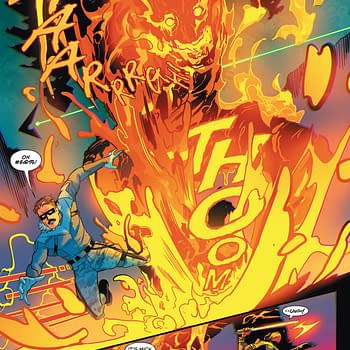Posted in: Comics, Recent Updates | Tagged: A Flock of Seagulls, dark horse comics, Dennis Calero, Eighties, frank miller, The Clash, The Suit, wall street
Sharp Dressed Man: A Chat With Dennis Calero On The Suit, Arriving In Dark Horse Presents This Week
By Jared Cornelius
Dark Horse Comics has been going through some big changes this year. With Disney's purchase of Star Wars the beloved publisher of modern classics like Fear Agent, Hellboy, and Usagi Yojimbo had a big void to fill. Fortunately, Dark Horse has an eye not only for talent, but for interesting concepts and series that don't fit into the traditional checkboxes of the other publishers. In particular they've had great success with weird interesting ideas like Shaolin Cowboy, spooky sci-fi with Grindhouse, and stylish period pieces like Lady Killer. Add to that list, The Suit, from longtime artist and writer Dennis Calero. Calero's name might not immediately spring to mind, but in all likelihood if you've picked up a comic in the last ten years you've read his work or seen his art. With credits to his name under the banners of Marvel, DC, Dynamite, Boom! Studios and more Calero has worked with characters across a wide range. This week on May 20th he's prepared to put his signature on Dark Horse's premiere anthology series Dark Horse Presents with his eighties opus, The Suit. I had the opportunity to sit down with Calero and discuss art styles, sharp dressed men, and A Flock of Seagulls.
Jared Cornelius: Can you give our readers a little background on The Suit?
Dennis Calero: I like to think of The Suit as a combination of James Bond and Wolverine. The Suit specifically came from a love of early eighties comics, Frank Miller's Daredevil being one of the primary influences. Then by association because Frank Miller was drawing so much from The Spirit. I went back to those as well and just had such a love of a character in a suit that gets torn up to me is such a wonderful image and I wanted to try to create my own version of that and celebrate all things eighties. With a lot of call outs to eighties culture, in the book specifically the first chapter there's news stories and references there's images on television the character will walk past John Lennon or Woody Allen in the street. Small little touches to celebrate a time that I probably idealize out of proportion, but it's always fun and has a lot of texture. In terms of the character himself, he's a Vietnam vet who now works as a corporate drone in the Wall Street style eighties Armani suits and all the classical accoutrement of the period except when he clocks in he takes a meeting, he really takes a meeting. I was really excited to explore a character of that nature with tongue planted firmly in-cheek the entire time.
JC: The story takes place as best as I can tell in the mid-eighties. Why set it during that particular time period?
DC: I'm not sure you remember the eighties quite the same way I do, I graduated in eighty-nine just as the eighties were ending and so I associate the eighties with my childhood and I just love the clash…I love The Clash. But specifically the clash of punk and new wave movement going on at the same time that there's this uber celebration of Reagan's corporate America and I find that time and that conflict to me is really interesting and the fashion and visual cues, and the music and details.
JC: You've done quite a bit of work in the Marvel Noir universe, do you prefer working in distinct time periods?
DC: I'm not sure it's about setting, I think that it's simply a matter of as an artist and I writer I have two different answers to that question. As an artist it's about being interested in what you're drawing and I think there's something about suits in the thirties, forties, and sixties that's very interesting to draw. The hat's, the cigarette smoke, the trench coat these are all very aesthetically pleasing that we just sort of lose by the seventies and by the eighties it's all gone. People wore suits to go on airplanes, I think it actually ties in to my answer as a writer because I also think there is an interesting sense of gentility still extant so to speak of previous eras at a time when sort of modern violence was really getting going in the way we perceive it now and that juxtaposition is really interesting. It's less interesting with a bunch of criminals dressed in jeans and T-shirts, is just not that interesting to look at or write about. I always prefer the gentleman criminal, there's a juxtaposition there…like what James Bond is all about, the gentleman spy. It's the man, the suit, that is capable at a moment's notice of horrifying violence and brutish brutal behavior and I find that stuff fascinating.

DC: I conceived of it as a three issue series that was then going to be serialized so my intention was always that I would do it a lot in the first part and then taper it off as we get into the world. So, for me it was an effort to have fun and to do something interesting and also an effort to very quickly acclimate the reader to the era through common references. It was also an effort at the beginning to offset…The first part is sort of its own little miniature story separate from the second and third parts. I wanted to be sure that there was a certain sense of satire and levity going through it even as there is some pretty heavy melodrama and it's unapologetic with melodrama going on through the climax of the first segment of the story. It was also a chance to have fun and draw John Lennon and Woody Allen and draw the old Carlyle Hotel, draw Grand Central from the eighties. Work through all these great things I remember from the time and also for me it's an interesting way to deal with all of those things that I remember being enchanted by as a child and look at them again through adult eyes.
JC: The main character, "Henry" we're lead to believe has a military background. Did you have any idea of where he came from in the military?
DC: I did not do a lot of research because it's a pastiche and I didn't want to be overloaded with…I did enough for there to be a certain resemblance too and hoping that the character is successful and people are interested in more stories I think that military background is something I'd revisit more often and too a greater depth in further stories. But for the moment my sense of it is he's a grunt, he was an infantry man, and saw a lot of action and the idea behind the character is he had all of this violence and all of this anger and trauma that he is trying to contain in the suit. The suit is also a reference to a lofty form of discussion, it's a way for him to contain his violence in his veneer, the veneer of his suit, the veneer of his company, the veneer of corporations, the veneer of money and success, and family. I believe the man loves his family, I believe before the events of this story he's probably the classic nineteen-fifties style American father. A little cold, a little distant, very hard working, not good with his emotions and in this case it's because of these traumatic experiences and a job that allows him to work out his therapy in a very hands on specific way that also happens to be very useful to some people.
JC: A lot of your work has been in established characters like the X-Men and Spider-Man, how was it starting from the ground up with The Suit?
DC: Writing is something I've always done, I remember when I was in college I sent in a Star Trek The Next Generation script. They had open submissions in those days and I got a call back from them, I was all of twenty-one years old and I got put on the pitch list for Deep Space 9 which I had idea how extraordinary that was and I had no idea about anything. I had no one in my life that was familiar with how the entertainment system worked or anything like that and I always kind of mistakenly saw writing as a secondary thing. I could write, but drawing is sort of more obvious, first of all drawing is more labor intensive so it feels more like work if you will than writing does in a lot of ways. It was also that there were a lot more people that could write in my immediate vicinity than could draw, so drawing was a big deal that was what I felt was special that I could bring to the table. I always still had the interest and I've always written and had things published and I had this idea for this character. Specifically the final moment and I actually lived in Tarrytown so a lot of that was informed by that iconography and that background.
So I had moments that I wanted to definitely express on paper and then let the character come forth from those moments and of course I fully admit that I had preexisting archetypes that I definitely wanted to work with. I wanted to go with the Frank Miller archetype of the man that will not die. I wanted to work with the James Bond archetype, of the gentleman killer. I wanted to work to work with the archetypes of from sixties new wave cinema, samurai, things like that so I had a lot of help. I had a skeleton, a very strong preexisting skeleton that I could drape if you will The Suit…pardon the pun, over that skeleton. So, it was one of the most gratifying creative experiences of my life and I can't say enough about how supportive Dark Horse, Mike Richardson and Jim Gibbons specifically were in helping me out. Jim Gibbons was specifically helpful in crafting the stories and making them better.
JC: Your art comes across very cleanly through the story. I thought chapter three in particular used light and silhouetted figures really well, was there a conscious effort to try and keep scenes like that a little starker than the rest of the book?

A little bit of column A, and a little bit of column B is usually how it works. I'm still coloring the last part as we speak and I'm finding things I'm interested in doing visually. Some of which I have to hold back because you want the package to feel unified whole. So, there is still stuff that I need to withhold for hopefully the next time out.
JC: Were there any particular materials, records, television shows, movies that you consumed while you were putting The Suit together to get you in the mood creatively?
DC: I listen to a lot of eighties music anyway, I remember once when I was working on something playing eighties music and my former brother-in-law said, "You like retro music, I do too!" and I was like what are you talking about? This is modern! This is Flock of Seagulls, its modern stuff! And I'm like, "Oh my god, this is terrible and can't be happening to me." Specifically I was listening to very early eighties, Duran Duran, Adam Ant, and Adam and The Ants, The Clash, obscure stuff like Kajagoogoo and Flock of Seagulls. Of course, David Bowie and Gary Numan some more esoteric stuff is a lot of fun to play with. I listened to a lot of classical as well to get me in the mood. In terms of movies Wall Street…American Psycho is a huge visual influence on what I was doing, whether you like that movie or not is a beautifully crafted film and was able to capture the spirit of the eighties without trying to be documentarian about it which is not what I'm trying to do. I went through old books of New York in the eighties and studied that kind of fascinating stuff, but I'm not trying to present the documentarian version of that period, but just to use it and manipulate it and give you some flavor to extenuate what's going on in the story. Wall Street….Platoon….Full Metal Jacket and The Shining to a certain extent just in terms of visual cues.

DC: It was the right place because Mike Richardson said we're putting it in Dark Horse Presents! So, that made it the right place. The story was always conceived even when I was thinking about twenty two page comics as a series of vignettes, as a series of cliffhangers. One of my favorite hobbies is to read old action comic strips, not comic books, but the actual James Bond comic strips and to watch how a story builds over time, but in very small episodic chunks each with its own miniature cliffhanger, sometimes big sometimes small, but always something where you wanted to find out what happens next.
I feel like so much of that has been lost. When you do that in comics nowadays its almost perceived as retro, just the idea that an issue of a comic just doesn't sort of end vaguely which happens so often in modern comics now and is called decompression or extending or whatever and I don't find it as fun. When I read a novel…the good novels every chapter reads like its own individual short story, every chapter ends with a punch that gets you into the next chapter. Episodic work needs to function both as a whole and episodes so Dark Horse Presents ultimately was the right fit.
JC: If The Suit was ever to make it to film or television who would be the ideal lead for the character?
DC: My dream leading man would be Michael Fassbender! I think that guy should be James Bond, I think that guy should be Batman, I think that guy should be everything! He's really a throwback to the steely eyed, serious, stoic leading man on top of being incredibly talented and always able to make any moment and any part more interesting with his presence and craft. My secondary answer would be that we would find some great unknown that would inhabit the part and make it his own.
The Suit will premiere in this month's issue of Dark Horse Presents, available this week on May 20th at finer comic shops everywhere and Dark Horse Digital. You can follow Calero on Twitter @DennisCalero.
Jared Cornelius is some guy from the Jersey coast who likes wearing a suit but doesn't get the opportunity very often. If you'd like to give him fashion advice, contact him on Twitter @John_Laryngitis.















